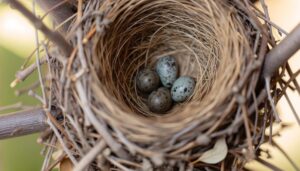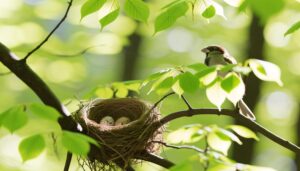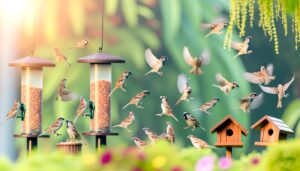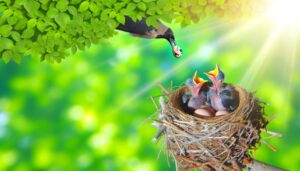Make Your Own Sparrow Feeder in 7 Easy Steps
Constructing a sparrow feeder necessitates weather-resistant wood or recycled plastic for durability. Utilize stainless steel screws and non-toxic glue for robust assembly.
Incorporate a fine mesh or wire screen to facilitate drainage and prevent mold growth. Placement is critical; position the feeder 5 to 7 feet above ground in an area removed from thick foliage and predator habitats.
Optimize feeding ports by ensuring even distribution to reduce competition and secure them with weather-resistant adhesives. Apply UV-resistant paint for environmental protection.
Proper construction and strategic placement can significantly increase visiting sparrows. For further insights into fine-tuning your feeder design, continue ahead.
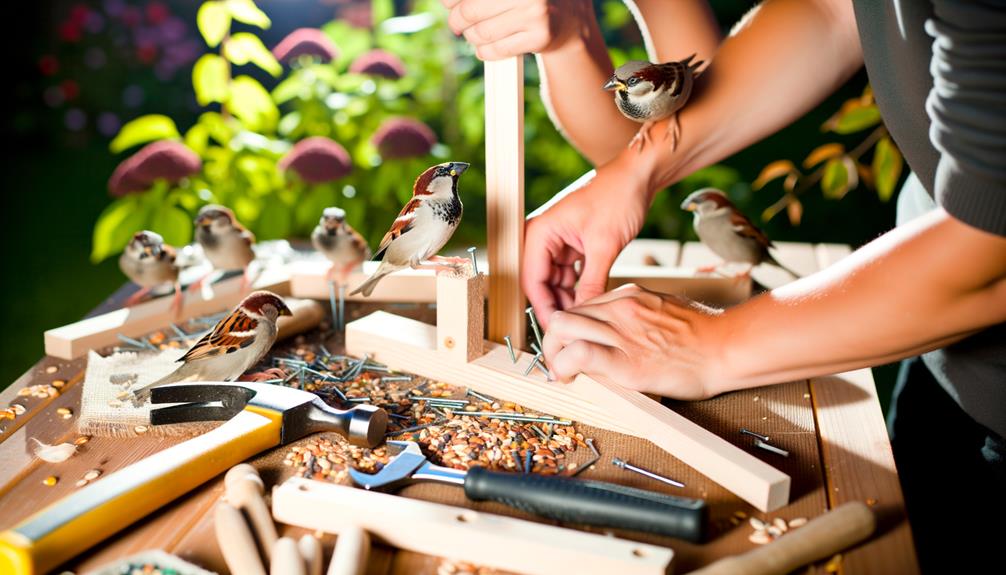
Key Takeaways
- Use weather-resistant wood or recycled plastic and stainless steel screws for a durable, safe frame.
- Install fine mesh or wire screens for effective drainage and mold prevention.
- Position the feeder at 5 to 7 feet high, away from predators and thick foliage.
- Paint with UV-resistant colors to attract sparrows and provide environmental protection.
- Secure feeding ports with weather-resistant adhesives or screws, ensuring even distribution and minimal competition.
Gather Your Materials
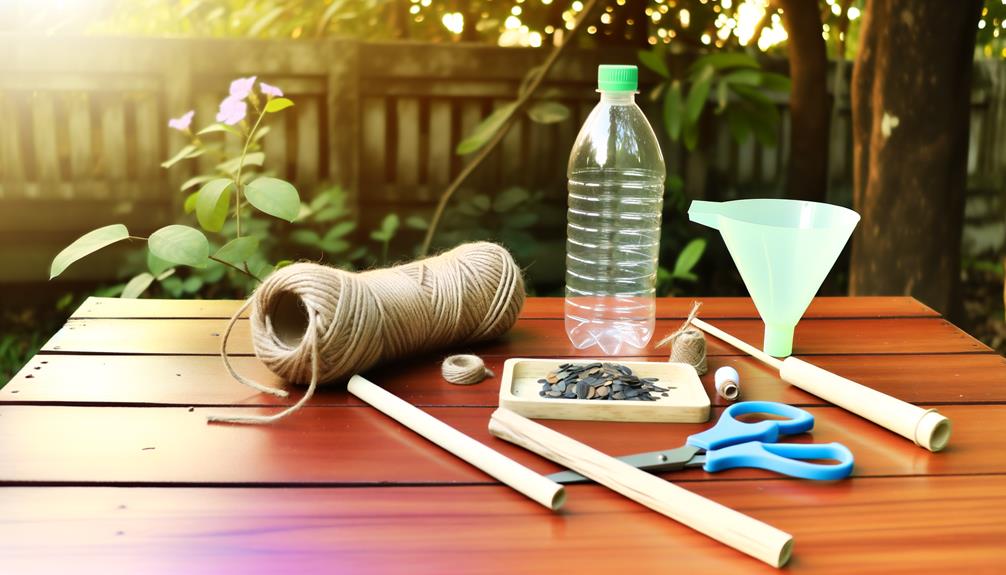
To construct an effective sparrow feeder, it is essential to gather specific materials that guarantee durability and functionality. Indispensable materials include weather-resistant wood or recycled plastic, which provide structural integrity.
Stainless steel screws and non-toxic glue are recommended for assembly, ensuring longevity and safety for the birds. A fine mesh or wire screen is necessary for the seed tray to facilitate drainage and prevent mold growth.
Additionally, opt for UV-resistant paint or sealant to protect the feeder from environmental degradation. Transparent polycarbonate sheets can be used for windows, allowing easy monitoring of seed levels.
Each component should be meticulously selected based on evidence of their resistance to weather conditions and non-toxicity to avian species, ensuring both the feeder's efficacy and the sparrows' well-being.
Choose the Right Location
Selecting a prime spot for your sparrow feeder is vital to ensuring its effectiveness and the safety of the birds. Best placement involves a thorough assessment of environmental factors. Position the feeder away from thick foliage and predator habitats to mitigate risks from cats or larger avian predators. Proximity to natural cover, such as shrubs or trees, offers essential escape routes for sparrows.
Additionally, consider the feeder's exposure to prevailing winds and precipitation; a sheltered location will enhance feeder longevity and food preservation. Evidence suggests feeders placed at heights between 5 to 7 feet deter ground predators while remaining accessible to sparrows. Regular observation of local bird activity can inform strategic adjustments, ensuring maximum utilization and safety.
Measure and Cut Wood
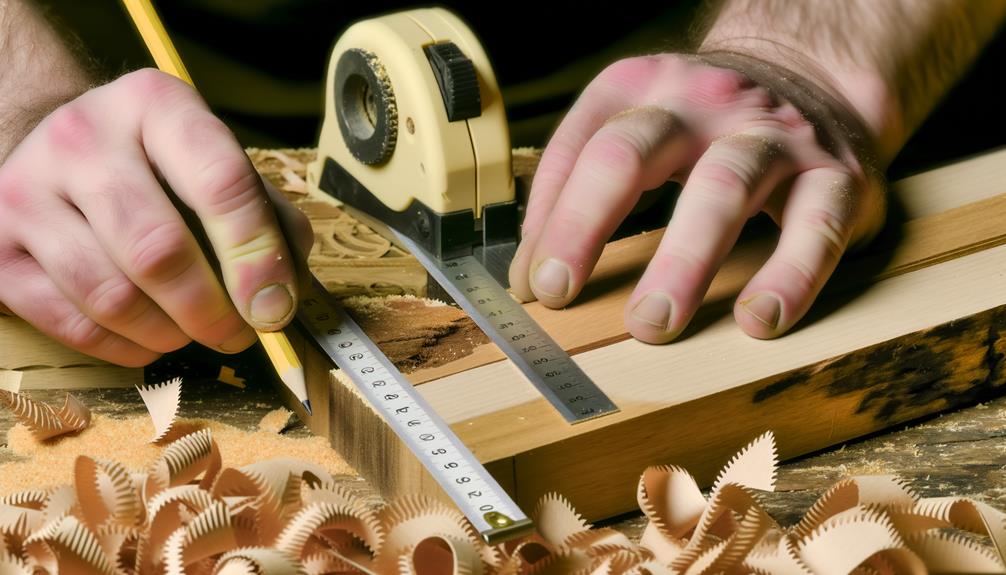
Accurate measurement and precise cutting of wood are fundamental steps in constructing an effective sparrow feeder. Begin by selecting high-quality, weather-resistant wood, such as cedar or pine, to guarantee durability.
Employ a calibrated measuring tape to delineate the dimensions of each component, typically including the base, side panels, and roof. Use a carpenter's square to confirm right angles, enhancing structural integrity. Mark these measurements clearly with a pencil.
Utilize a fine-tooth saw or a table saw for cutting, adhering to safety protocols to prevent splintering. Verify each piece post-cutting with the initial measurements to secure precision.
This meticulous approach guarantees that the feeder components will fit together seamlessly, fostering a stable and functional design.
Assemble the Feeder Frame
Begin the assembly by aligning the pre-cut wooden components, affirming that the edges meet precisely to form a stable feeder frame.
Utilize a carpenter's square to confirm 90-degree angles at each corner, promoting structural integrity.
Apply wood glue along the contact surfaces, securing an even distribution to maximize bonding strength.
Clamp the pieces firmly in place, maintaining pressure while the adhesive cures.
For added stability, reinforce the joints with galvanized screws, positioning them approximately 2 inches apart.
Pre-drill pilot holes to prevent wood splitting and guarantee accurate screw placement.
Observe the assembly for any misalignments, making necessary adjustments promptly.
This meticulous process assures a robust framework, essential for supporting the subsequent feeder elements and enduring outdoor conditions.
Add Feeding Ports
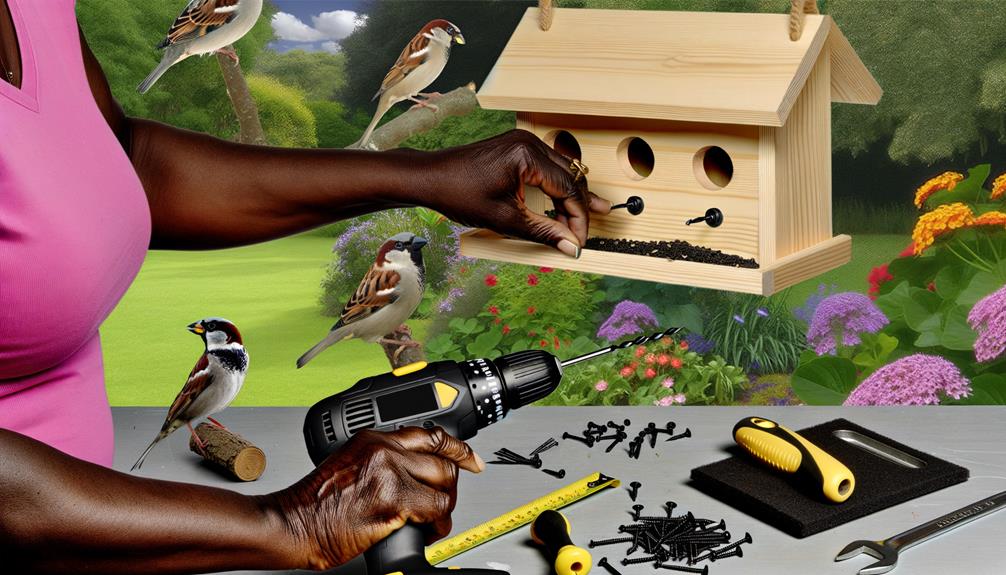
To optimize the effectiveness of your sparrow feeder, it is important to strategically select the locations of the feeding ports, ensuring they are evenly distributed to minimize competition among birds.
Empirical studies suggest that secure attachment methods, such as using weather-resistant adhesives or screws, can greatly enhance the structural integrity of the feeder.
Properly positioned and securely attached feeding ports will not only facilitate ease of access for sparrows but also prolong the feeder's usability under varying environmental conditions.
Choosing Port Locations
Selecting top port locations is important for guaranteeing that sparrows can easily access the feed while maintaining the feeder's structural integrity and minimizing waste. Empirical observations and avian feeding behaviors indicate the following guidelines:
- Elevation from Base: Ports should be placed at varied heights to accommodate sparrows of different sizes and feeding postures.
- Radial Distribution: Ports arranged radially guarantee equitable access and reduce territorial conflicts among feeding sparrows.
- Spacing: Adequate spacing between ports (approximately 2-3 inches) prevents overcrowding and enhances feeding efficiency.
- Orientation: Ports should be oriented horizontally to minimize spillage, leveraging gravity to regulate feed flow optimally.
These considerations, based on avian ergonomics and feeder design principles, ensure maximum utilization and longevity of the sparrow feeder.
Secure Attachment Methods
Ensuring the secure attachment of feeding ports requires meticulous attention to material compatibility and structural integrity to withstand environmental stressors and frequent use by sparrows. Empirical evidence suggests that utilizing corrosion-resistant screws or rivets provides superior durability. Additionally, employing waterproof adhesives enhances bonding strength between dissimilar materials. Key factors to take into account include tensile strength, load distribution, and resistance to UV degradation.
| Material Type | Recommended Fastener |
|---|---|
| Wood | Stainless Steel Screws |
| Plastic | Nylon Bolts |
| Metal | Galvanized Rivets |
| Composite | Waterproof Adhesive |
Proper alignment and spacing of feeding ports optimize accessibility and reduce competitive behavior among sparrows. Regular inspection and maintenance of attachment points are imperative to prevent loosening or detachment, ensuring the feeder remains functional and safe for avian use.
Attach Perches
Safely attaching perches to the sparrow feeder is crucial to provide stable platforms for the birds to comfortably access the food. Perches should be positioned strategically around the feeder to optimize accessibility and minimize territorial disputes.
Empirical observations suggest that sparrows prefer perches that are:
- About 1 cm in diameter, which provides a comfortable grip.
- Separated by at least 10 cm, reducing competition and guaranteeing sufficient feeding space.
- Constructed of non-slip materials, such as untreated wood or textured plastic, to prevent slipping.
- Securely anchored, either by using screws or strong adhesive, to withstand weather-related wear and tear.
These specifications are based on ornithological studies and guarantee that perches are both functional and safe for sparrows.
Paint and Decorate
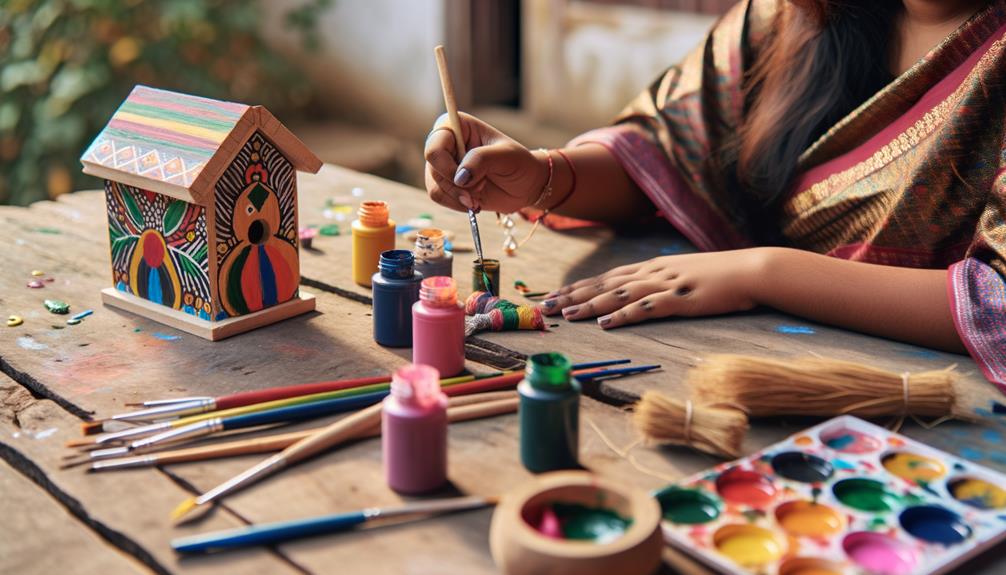
When painting and decorating your sparrow feeder, choosing vibrant colors can attract the birds while adding aesthetic value.
Introducing personal touches, like custom patterns or initials, can enhance the uniqueness of the feeder.
Furthermore, applying a weatherproof sealant is crucial to safeguard the feeder from environmental elements and guarantee longevity.
Choose Vibrant Colors
Selecting vibrant colors for your sparrow feeder is essential, as research indicates that birds are more attracted to feeders that stand out in their environment. Studies have demonstrated that color intensity and contrast play a noteworthy role in avian visual perception.
To maximize attractiveness and functionality, consider the following color choices:
- Red and Orange: These warm hues are particularly effective in catching the eye of sparrows.
- Yellow: Known to stimulate feeding behavior in many bird species.
- Blue and Green: These colors blend well with natural surroundings but still offer ample contrast.
- White: Provides high visibility and can attract a variety of bird species.
Employing these hues can notably enhance the likelihood of sparrows frequenting your feeder, thereby promoting avian biodiversity.
Add Personal Touches
Enhancing your sparrow feeder with personalized touches such as painting and decorative elements can greatly increase its aesthetic appeal and functionality. Empirical evidence suggests that vibrant colors attract more birds, particularly sparrows.
Utilizing non-toxic, water-based paints guarantees safety for avian visitors. Detailed observations indicate that strategically placed decorative elements, such as small perches or mirrors, can facilitate sparrow landing and feeding behaviors.
Additionally, incorporating natural materials like twigs or leaves can mimic sparrows' natural habitat, promoting frequent visits. By combining aesthetic enhancements with functional design, one can create an inviting and practical feeding station.
This approach not only benefits the birds but also provides a visually pleasing garden feature, fostering a harmonious interaction between humans and wildlife.
Weatherproof Your Design
A critical consideration in designing a sparrow feeder is ensuring that its structure and decorations are weatherproof to withstand various environmental conditions. Applying suitable materials and coatings can greatly enhance durability and longevity.
For effective weatherproofing, consider the following:
- Use exterior-grade paint: Opt for paints specifically formulated for outdoor use to resist moisture and UV radiation.
- Apply a clear sealant: A UV-resistant sealant can provide an additional protective layer against weather elements.
- Choose rust-resistant hardware: Stainless steel or galvanized screws and nails prevent corrosion over time.
- Incorporate weather-resistant wood: Cedar or redwood are excellent choices due to their natural decay resistance.
Fill With Birdseed
To guarantee peak nutrition for sparrows, fill the feeder with a high-quality birdseed blend specifically designed for small birds. Such blends typically include millet, sunflower hearts, and cracked corn, which are highly favored by sparrows.
Millet offers essential carbohydrates, while sunflower hearts provide protein and fats, essential for energy and feather maintenance. Cracked corn is easily digestible, ensuring efficient nutrient absorption.
Observational studies have demonstrated that sparrows exhibit increased visitation rates and longer feeding durations with these compositions. Avoid using seed mixes containing large seeds or fillers, as sparrows may struggle to consume them, resulting in wasted feed.
Ensuring best seed quality directly impacts sparrow health, promoting robust immune function and reproductive success.
Install and Maintain Feeder
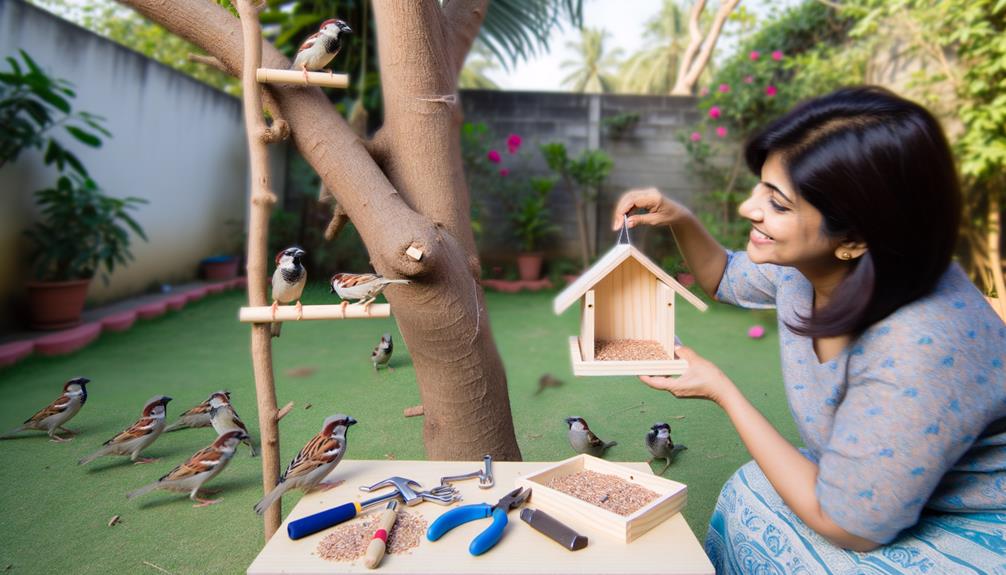
Proper installation and ongoing maintenance of the sparrow feeder are essential to ensure peak foraging efficiency and feeder longevity. To optimize these factors, consider the following scientific guidelines:
- Location: Position the feeder in a sheltered area to minimize exposure to wind and precipitation, enhancing bird accessibility.
- Height: Install at a height of 5-6 feet to deter ground predators and facilitate easy observation.
- Cleaning: Conduct weekly cleanings using a 10% bleach solution to prevent the spread of avian diseases.
- Inspection: Regularly inspect for wear and tear, promptly repairing any damage to maintain structural integrity.
Conclusion
To sum up, the construction and installation of a sparrow feeder require careful attention to material selection, precise measurements, and strategic placement.
By following these systematic steps, the development of a functional and visually appealing feeder is attainable.
This process mirrors the meticulous craftsmanship of Daedalus, whose creativity in design was crucial. Such thoroughness guarantees not just the attraction of sparrows but also a sustainable feeding environment, promoting avian diversity and aiding in ecological equilibrium.


